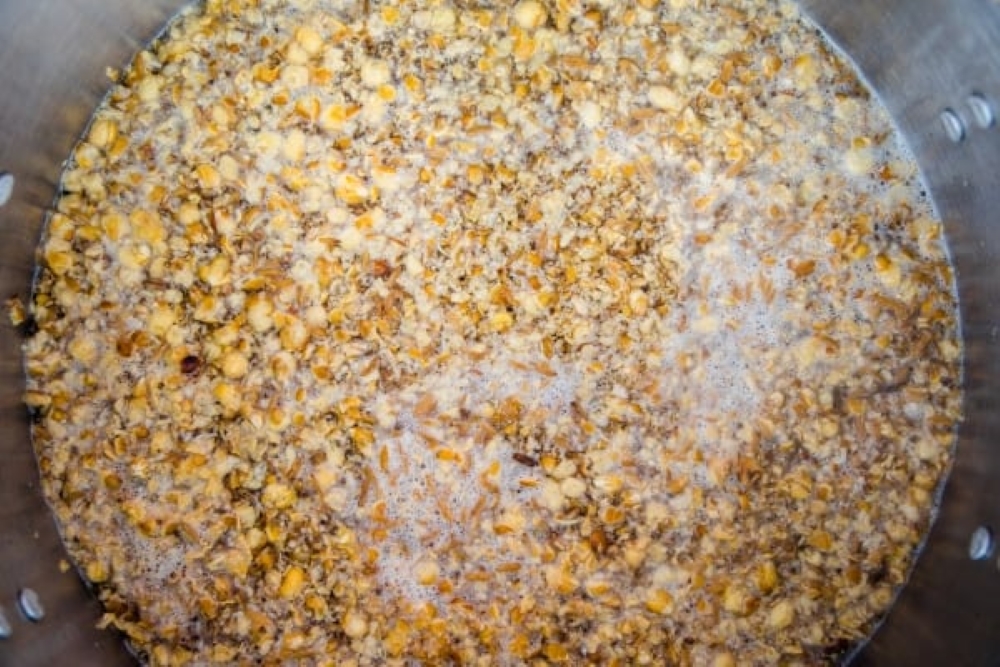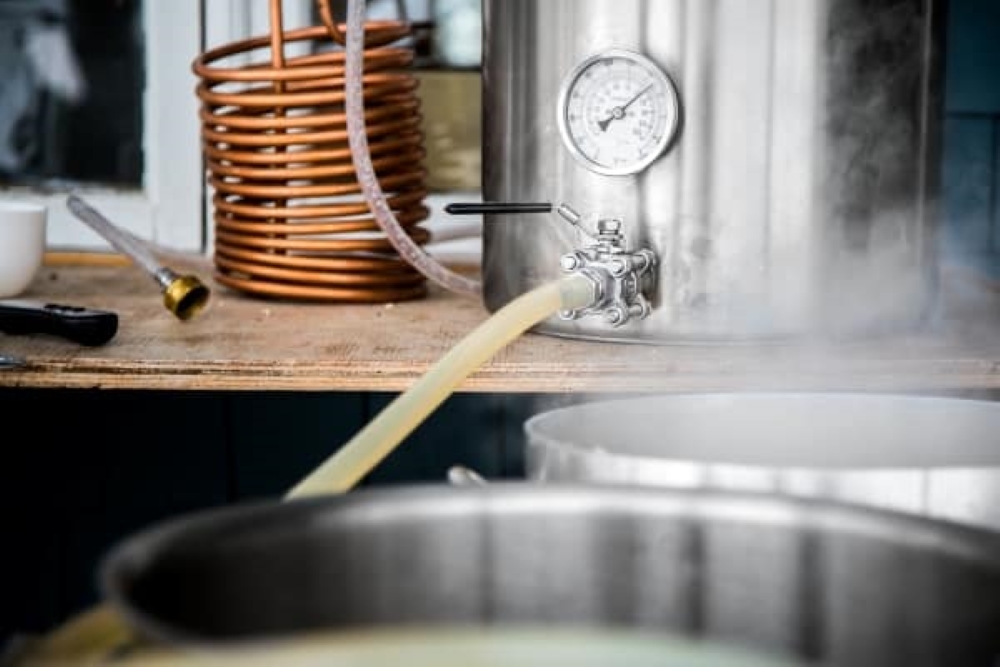Choosing The Right Home Brew Kit
But starting your own brewery isn’t always as easy as just bagging yourself a nice-looking home brew kit, as the market is currently saturated with thousands of such products, which range drastically between beginner and expert in terms of what’s included within them.
Brewing beer is an exact and difficult science and while anyone can now do it at home, you still need to make sure you have all the equipment and know-how available to you to get things right.
Before you buy any brewing kits, beginner or otherwise, you always need to look at grain, hops and yeast quantities, the type of beer the kit makes, the experience level needed, the amount of final product produced and finally, the alcohol percentage.
If you are a complete beginner though, you’re going to need to be a little more careful when buying brewing kits, as the likelihood is you don’t yet have the tools to brew them…
What a Complete Brewing Kit Looks Like
Home brew kits vary in the amount of free equipment they give you, with some not providing any at all, which is helpful to advanced brewers who could do without a house full of brewing paraphernalia.
However, if you are new to the practice or are treating it as a bit of a novelty, it’s important to plump for a complete brewing kit which provides you with everything you need.

The essentials to any good home brew set up are:
- A large plastic bucket with airlock lid and stopper
- Fermentation bucket
- Nylon bags for grains and hop straining
- Hydrometer
- Thermometer
- Food safe sanitiser
- Mixing paddle or large spoon
- Racking cane/siphon
- Bottles, kegs or pressure barrels for finished product (capper or bottling wand also needed if bottles)
- Brewing kettle (only if an advanced recipe)
Use this list as your definitive checklist for home brewing equipment and always be sure to study the contents list of any kit, especially ones which claim to have everything you need to get started.
All of this equipment can be bought separately if you struggle to find a truly complete kit and as you become a more advanced brewer, you may find you want to upgrade your individual pieces to more expensive, purpose-made equipment.
However, for someone starting out, a home brew kit which contains all of these things is going to save you a lot of money and time scoping around for different bits and pieces! It also means that once the kit is in your hands, you don’t have to hang about, you can simply get on with brewing as soon as you see fit!
It’s also important to note that the actual quality of such included equipment will often differ drastically between brands. It’s always worth considering a kit which promises high-quality and professional equipment that’s tailored to your chosen type of brew over a fully complete set that doesn’t quite cut it!
If in doubt as a beginner, make sure you’re shopping for starter kits as these are the most likely to contain helpful instruction information as well as the items you need.
Recipe Only Kits
Kits that have no equipment are designed for experienced brewers or those who have blasted their way through two or three beginner kits with ease and now find themselves in a position of having all the necessary equipment and a little bit of know-how to boot.
Recipe or refill packages are pretty much ingredient kits, providing you with grains, hops and yeast at a minimum with most offering extra flavourings and extras too depending on how unique or unusual the particular recipe is.
Hopefully, they will also come with instructions, so that you can be confident in how to go about getting the best out of your kit and turning it into a drinkable bevvy!
Checking Your Ingredients
As previously mentioned, it’s absolutely crucial that your kit contains a form of grains, hops and yeast.
Grains are the base of all beers, hops are vital for flavour and taste, and yeast is what converts your mixture into alcohol and gives it carbonation.
However, you need to read the labels of your kit carefully as some specific types of brew require extra ingredients which aren’t always included.

This may be a certain kind of sugar or flavouring which you will need to buy separately and you need to consider whether a kit is actually worth it’s price if you’re having to spend a load of extras to complete the recipe!
In terms of your main three ingredients, it’s also important to consider the types of hops and yeast included.
As hops have so much influence on taste, it’s wise to read into the particular hop your chosen kit includes, as you can then decide whether this is a flavour you’re going to enjoy or not.
There are also many strains of yeast which can have various influences on fizz, alcohol strength and even smell. Always read through the product description thoroughly or read reviews of that strain of yeasts results to help inform your decision.
Home Brew Kit Buying Guide
Things To Consider Before You Buy A Home Brew Kit
Type, Strength & Quantity
This is the easy part. What kind of beer do you want to make? How strong do you want it to be? And how much do you want to make?
The answers to these questions are, within reason, up to you and it’s helpful to have a clearer idea of what you want to achieve when searching for a kit, as it makes finding the perfect product a much quicker process!
Ultimately you want to choose something which suits your taste and ABV preference, which also provides you with a quantity you can feasibly handle within your storage facilities.
Difficulty of Beer Type
Despite your choice of beer type being completely up to you, how easy or successful you will actually find the venture will often be completely down to your experience level and know-how, as some forms of beer are much harder and more time consuming to master.
For beginners we’d recommend a lighter form of beer such as pale ale or IPA, as not only do they give off wonderful flavour, but they’re also the easiest to get the hang of. Hence why there are so many growing IPA start ups out there. The hardest type of beer to brew at home is lager, hence why there are very few lager start ups, and very little choice of home brew kits for this type of beer!

Checking the ABV
ABV stands for alcohol by volume as I’m sure you already know and it’s always important to check the strength of the purported beer you’re going to make.
While everyone knew someone in their teenage years who brewed up a bizarre, stinking beer of frighteningly high ethanol proportions, the aim of home brew kits is not to make a potentially lethal beverage and blow everyone’s head off.
If a kit does not have a specified ABV listed, be very wary, as this means there’s more chance of you going wrong. If this is the case, you absolutely need a hydrometer to check the final alcohol percentage, which is defined by the number of millilitres of pure ethanol per 100 millilitres of solution at 20℃.
Assessing Quantity
If a kit does not explicitly state how much the finished product will equal in pints, it can be confusing to work out how much beer you’re going to end up with!
If this is the case, you’re simply going to have to dome basic conversion math, but don’t worry, we’ll give you a brief example!
One of the classic kit amounts you’ll see is 23 litres, which equals approximately 40 full pints.
These are often the larger amount, which will allow you to share your finished product with impressed friends and family!
If you’re new to the game though and aren’t quite sure what you’re getting into, it’s best to go with a smaller kit which will result in 20 pints are less. This will avoid you discovering you don’t have the facilities to store vast amounts of booze and means your family won’t be forced to drink your home brew batch for the rest of the year. (They’ll be especially glad for this foresight if it turns out to be a disaster too!
Ease of Use
Probably the most important point for most people, not everyone wants to become a master brewer or has the patience to read an in-depth manual on beer brewing. It’s therefore wise to buy a kit which promises ease of use and fantastic results with very little research and reading time. Home brewers want to be doers not revisers!
Ultimately, how easy a kit is to use is often dependent on the equipment you’re provided with.

For example, if you aren’t given a siphon for transporting your boiled grains (wort) into a fermentation bucket for the next stage of brewing, how would you even go about performing this?
If you aren’t even bothered by the process of brewing at all and simply want to be able to tell your mates you’ve brewed a beer, there’s even electric kits/microbrewing systems which take home brewing to the next level, allowing you to concoct a recipe with just the touch of a few buttons!
Cleaning
Ah yes… the part that nobody gives any thought too.
While brewing beer at home might seem like a great big barrel of laughs, the part that nobody tells you about is all the cleaning that needs to be done!
Sanitation is vital to ensuring your beer is healthy and safe to consume and so you need to take proper precautions when brewing. Because you wouldn’t cook your family a meal using last night’s unwashed frying pan would you?
Although it’s rare, some kits will include cleaning tools to help you with this process, such as bottle brushes and food-grade sanitisers, more often than not though, they won’t, merely offering you instructions on how and when to go about scrubbing up!
This means it’s often up to you to source your own cleaning equipment. Once you’ve chosen a suitable sanitiser (VWP, Chemisan, PBW or other food-safe products), you’re then ready to tackle all your dirty kit.
On brewing day, you’ll need to clean everything your beer has touched, and after bottling or storing finished products in a keg you’ll also need to wash any tools you’ve used.
Storage
Although it’s difficult given you should know how much product you’re going to make, please don’t make the mistake of having too few bottles or not a large enough keg to store away your finished beer!
If you’ve bought a starter kit with storage facilities included this won’t be a problem, but if you’re expected to provide your own, make sure you get it right!




